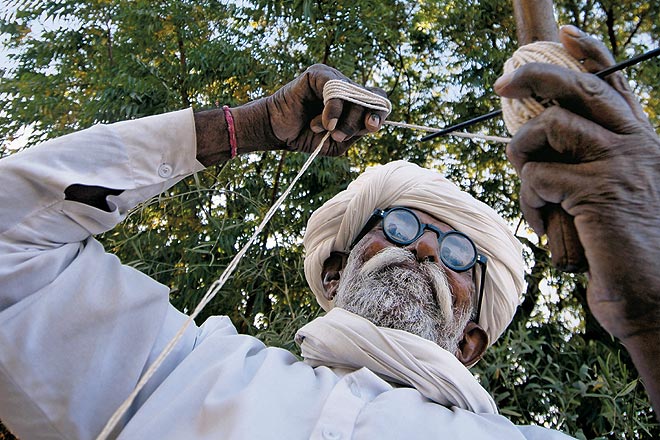RAJASTHAN sizes="(max-width: 660px) 100vw, 660px" />
sizes="(max-width: 660px) 100vw, 660px" />
Bishnoi villages: It is a must-do if you have come as far as Jodhpur, a desert safari or camping experience that includes Bishnoi hospitality. A rural sect of potters, weavers, leather workers and camel herders, the Bishnoi are distinctive for their intensely eco-friendly faith and historic tree huggers. A vegetarian community, all its members are dedicated to safeguarding and honouring all life, regarding themselves as custodians of nature. Not a tree will be felled, no animal slaughtered by these people. The rare blackbuck roams among them ridiculously secure in its safety. Remember to bring home a dhurrie from the weavers of Salawas, patterned with coarse cotton, wool and the hair of goats and camels. In winter, wildlife gathers at Guda Bishnoi Lake. One other peculiarity is the Bishnoi’s licence to grow opium for religio-cultural observances, something outlawed in India generally.

Bhainsrogarh: On the road from Chittor to Bundi, in the Kota district, stands a heritage hotel—formerly the fort of Bhainsror, set 200ft up on a slate cliff overlooking the Chambal, with the Bamani River guarding its back on the other side. The 2nd-century BC fort has been ‘gently restored’ by the formerly royal family who still make their home there, its kitchens still serving ancestral recipes handed down over generations. The 9th-century Hun temples of Badoli are a day trip away. On a boat ride down the Chambal or off the ramparts, muggers and gharials can be spotted. Anglers might be so fortunate as to hook a mahseer. Wildlife watchers may prefer an excursion to Mukundara Hills National Park or the forested fort of Hingalajgarh.
GUJARAT

Velavadar National Park: Bhavnagar’s blackbucks were once hunted by the maharajah’s cheetahs, now they are sought by wildlife enthusiasts touring the Velavadar National Park, now that the princely state is no more and the animals enjoy some protection from predatory humans. The lesser florican, striped hyena and wolves are the other species sustained by its conservation programmes. The historic city of Bhavnagar, a port with a natural harbour and capital of the erstwhile princely state, is nearby and offers the Nilambag Palace for heritage lodgings if you would rather not park at the forest department’s guesthouse.

Champaner-Pavagadh: The state’s only World Heritage Site is really several in one Archaeological Park package. Clustered around the historic capital of Sultan Mahmud Begada, Champaner, there is everything from chalcolithic sites to an early Hindu hill fortress and the remains of the 16th-century capital. One of the most interesting aspects of the architectural evidence it offers is the 15th–16th century gradual transition from Hindu to Islamic culture and craftsmanship, before the better-known Mughal influences filtered in—the Gujarati Sultans were of Turkish descent—including carved sandstone mosques and monuments, plus superior urban planning. There is a cluster of Jain temples of significance too. It is also a geologically interesting area with steep rock exposures showing evidence of volcanic eruptions and lava flows. Hindu lore makes it a shakthipeeth, bringing pilgrims to the Kalika Mata Temple, supposedly sited where her right toe fell.
MAHARASHTRA

Murud: The marine fort of Janjira sits on an oval corner of the port city of Murud, south of Mumbai along the Western Ghats. Once the small wooden stronghold of a Koli chief, it grew into a stone fortress under subsequent rulers. Its 21 bastions still stand, with cannons both native and European. Besides a postern out to sea to escape armies attacking from the land, called the Darya Darwaza, it also has a freshwater lake within its ramparts, the secret to its success against the sieges of Maratha kings, as well as the Dutch and the English East India Company.

Kaas plateau: Maharashtra’s 1,000 ha Valley of Flowers, the Kaas Pathar blooms purple from mid-September to early October—and pink, and white, and yellow. There are some 850-odd species of orchids, karvy and more, including the carnivorous Drosera indica. An UNESCO biodiversity site, it sits a 3.5-hour drive from Pune, with the Sajjangadh Fort, turned into a monastery in Shivaji’s reign, and Shivsagar Lake within hiking distance. The Sahyadri Tiger Reserve too is cheek by jowl.
GOA

The hinterland: Believe it or not, there is more to Goa than its beaches and churches and seafood shacks. Inland Goa and its rivers don’t get much of a looksee into tourist maps, but they should, they should, they should. There are temples, just as many as the churches on the shoreline—and some, like the Saptakoteeshwara, are actually church-shaped, like this one founded on a Latin cross; others are unique for having survived, like the 13th-century Tambdi Surla from the Kadamba era, the only surviving black-basalt shrine of its kind and the oldest in Goa. There are the Chorla Ghats on the borders of Karnataka and Maharashtra. There are resorts that specialise in ecotourism—sited in plantations, or areas good for birding, or on top of jungle streams where wildlife are drawn to drink—including the government-run Cotigao eco-tourism complex. There are beautifully preserved little townships of Portuguese homes, like Chandor, which offer guided walks. Life isn’t always a beach in Goa, but it is still beautiful and gentle.
unexplored places in India
western India
Leave a Reply
You must be logged in to post a comment.


